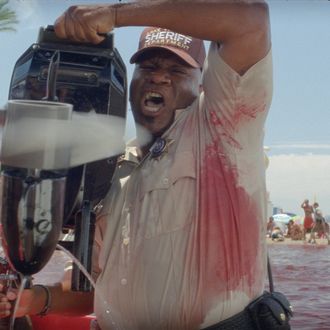
After 3-D was revived in 1981 with the literally titled western Comin’ at Ya!, the comin-at-ya format became primarily a boon for slasher sequels (Amityville 3-D), cheesy sci-fi (Spacehunter: Adventures in the Forbidden Zone), and, in the nineties, IMAX mini-movies (Wings of Courage). But in 2009, for the first time since Alfred Hitchcock made Dial M for Murder, James Cameron made 3-D attractive to auteurs with Avatar. Martin Scorsese’s Hugo is coming out later this month, Peter Jackson and Steven Spielberg’s Tintin just premiered around the world ahead of its December U.S. release, and Bernardo Bertolucci’s Oscar-winning The Last Emperor is reportedly undergoing a 3-D revamp. (The director even considered shooting his new film in 3-D, but then apparently decided not to.) And as 3-D’s march toward respectability continues, it’s becoming clear that that is exactly the wrong direction. 3-D shouldn’t be heading toward subtlety, it should be storming right at your face, preferably carried by a wave of bodily fluids, severed penises, or anything else puerile or disgusting — the possibilities are endless, and delightfully gross. Schlocky, gratuitous 3-D is worth a four-dollar surcharge in a way that the delicate, artful, Great Director version of 3-D isn’t.
One can appreciate how talented directors are using 3-D to enhance their palette and not just as a gimmick. It was great when Up opened up the fictional South American land of Paradise Falls and made it seem like a palpably real, impossibly lush and verdant place, providing a nice contrast to the film’s earlier, urban scenes. And there’s a beautiful moment in Hugo when a pile of ash blows out of the hero’s hands as he opens up a beloved, now supposedly destroyed, book. But you know what was really awesome? A man-eating fish burping out Jerry O’Connell’s half-eaten wang in Piranha 3D. Danny Trejo jizzing on a Christmas tree and bags of cocaine exploding in our faces in A Very Harold & Kumar Christmas. The “dildo bazooka” in Jackass 3D. The “Poo cocktail supreme” in Jackass 3D. The “helicockter” in Jackass 3D. These are moments that are truly enhanced by — nay, which demand — 3-D.
Yes, this is the platform of a vulgarian. But let’s face it, 3-D is a vulgar concept and always has been. Remember boiling wax being poured on you in House of Wax? The too-cheesy-to-be-forgotten roller-coaster fight in Man in the Dark? Ernest Borgnine shooting us in the face in The Stranger Wore a Gun? Okay, maybe not everybody remembers those classic effects, but they were pretty fantastic. (Ironically enough, most of us who do remember them probably do so because we saw them at ever-so-respectable retrospective houses like New York’s Film Forum.) 3-D should be tasteless, and gratuitous, the tool of modern Dr. Tongues. It suits the slo-mo close-up of the Christmas ornament shard on which we see the reflection of someone bleeding to death in Harold & Kumar. We’re worried that all this respectability is distracting moviegoers from what 3-D really should be used for: throwing stuff at the audience and watching them duck, squirm, and giggle. (Michael Bay was made for it; short of him clubbing moviegoers on the head, 3-D is the only way to make films like Transformers: Dark of the Moon more literally bombastic.)
Seeing Up in a 3-D theater was a treat. But when you now watch it on a 2-D Blu-ray, you never feel like you’re missing out on something. Up is still Up. It’s still great in 2-D. (And the same, we suspect, will go for Hugo, when it eventually comes out on Blu-ray.) As Bob Whitehill, Pixar’s 3-D supervisor, once put it, “I think we worry a little less about the 3D effect than about the story and emotion … I think we would err on the side of caution and an easy viewing experience and fitting in with the narrative rather than trying to really accentuate the 3D.”
And it’s great that Pixar is, for the most part, not trying to blow our eyes out of the backs of our heads with 3-D effects. (God knows, they probably could if they wanted to.) But read between the lines of Whitehill’s comments and you’ll find a tacit acknowledgement that 3-D is, on some level, unnecessary to these films. 3-D may need Pixar, but Pixar doesn’t need 3-D. A film as beautifully imagined and made as Toy Story 3, or as lovingly filmed as Hugo, may have some great additional visual depth in 3-D, but it doesn’t need it.
That’s not going to be the case with Harold & Kumar Christmas, we suspect. It’s a funny movie, but it’s extremely funny in 3-D. The folks who will see it in 2-D on cable or DVD will be missing something by not being enveloped in pot smoke the way 3-D viewers were. We feel bad for those folks the same way we feel bad for all the folks who will miss seeing a tazed piranha exploding in 2-D in Piranha 3D. It’s time for 3-D to stop trying to be so damned respectable. Because it’ll always feel like an impostor in le cinema du Martin Scorsese. It needs to go back where it belongs — into the warm, pee- and-poo-soaked arms of le cinema du Johnny Knoxville.





